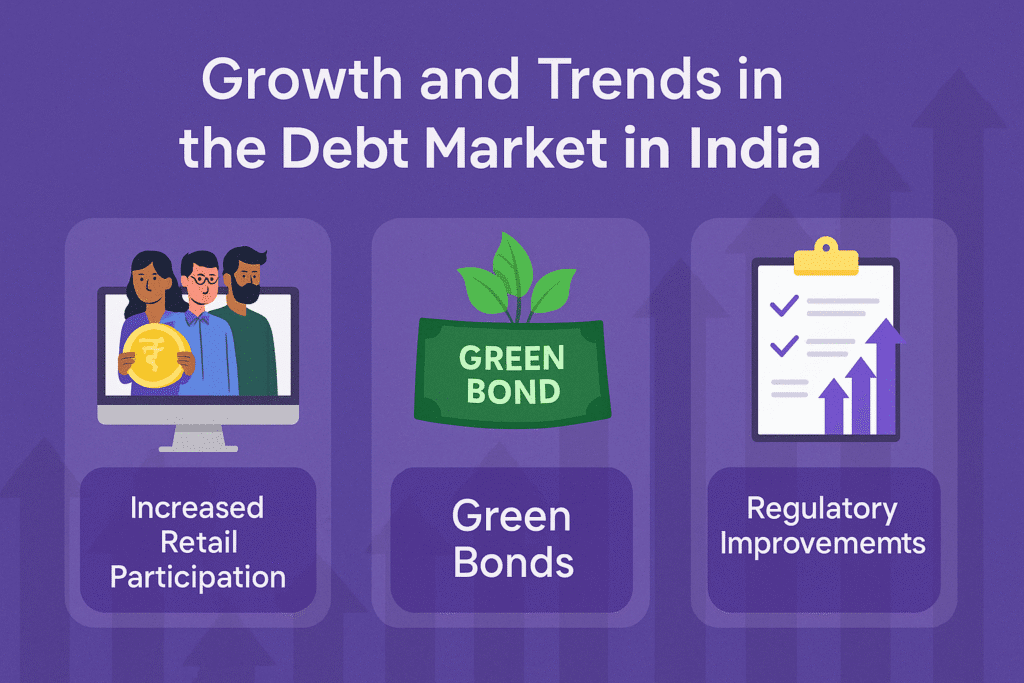Understanding the Debt Market in India in 5 minutes
The financial world thrives on the constant movement of money. Businesses need capital to grow, governments require funds for infrastructure projects, and individuals seek opportunities to invest their savings. The Debt Market in India plays a crucial role in facilitating this exchange by connecting borrowers with lenders. It acts as a backbone for the economy, ensuring that funds are available to fuel development, manage public finance, and create investment avenues.
This article offers a comprehensive look into the Debt Market in India, exploring its structure, participants, instruments, benefits, and the factors that influence its operation. Whether you are a seasoned investor or a beginner, understanding the dynamics of the debt market can empower you to make informed financial decisions.
What is the Debt Market in India?
The Debt Market in India is a vast network where entities such as governments, financial institutions, corporations, and other organizations issue and trade debt instruments. These instruments, commonly referred to as fixed-income securities, represent a borrowing agreement where the issuer commits to repaying the principal amount along with a pre-agreed interest to the investor.
Debt instruments provide an alternative to equity financing, allowing issuers to raise capital without diluting ownership. For investors, they offer relatively safer investment options compared to equities, often yielding regular income in the form of interest.
Key Participants in the Debt Market in India
The Debt Market in India comprises a broad range of participants, each playing a unique and essential role in its efficient functioning:
1. Issuers
- Government of India: Issues instruments like Government Securities (G-Secs) and Treasury Bills.
- State Governments: Issue State Development Loans (SDLs).
- Municipal Corporations: May issue municipal bonds.
- Public Sector Undertakings (PSUs): Issue bonds and debentures to fund operations.
- Private Corporations: Issue corporate bonds and debentures.
2. Investors
- Banks and Financial Institutions
- Insurance Companies
- Mutual Funds and Pension Funds
- High Net-Worth Individuals (HNIs)
- Retail Investors
3. Intermediaries
- Stockbrokers and Dealers: Facilitate transactions in the secondary market.
- Underwriters: Assist in the issuance of debt instruments.
- Rating Agencies: Evaluate and rate the creditworthiness of issuers.
Types of Debt Instruments in the Indian Debt Market
Understanding the variety of instruments available in the Debt Market in India is essential for both issuers and investors. Each instrument has its unique features, risk level, and return potential.
1. Government Securities (G-Secs)
These are long-term debt instruments issued by the Government of India. They carry a sovereign guarantee, making them the safest investment options. G-Secs are issued with varying maturities, ranging from a few years to as much as 40 years.
2. Treasury Bills (T-Bills)
Short-term instruments with maturities of 91, 182, or 364 days. T-Bills are issued at a discount and redeemed at face value. They are commonly used by institutional investors for short-term fund parking.
3. State Development Loans (SDLs)
Issued by individual state governments to fund their fiscal needs. SDLs carry slightly higher interest rates than G-Secs but are also considered low-risk.
4. Corporate Bonds
Issued by private or public sector companies to raise long-term capital. Corporate bonds offer higher yields than government securities but come with increased credit risk.
5. Debentures
Similar to bonds but typically unsecured. These are backed by the creditworthiness of the issuer rather than any physical asset. Debentures can be convertible or non-convertible.
6. Municipal Bonds
Issued by local governing bodies to fund infrastructure projects like roads, sewage systems, and public transportation.
7. Commercial Papers (CPs)
Short-term unsecured promissory notes issued by corporations to meet working capital needs. They generally offer higher returns than T-Bills.
Benefits of the Debt Market in India
Participating in the Debt Market in India offers a plethora of benefits for both issuers and investors.
For Issuers:
- Access to Capital: Helps raise funds without diluting equity.
- Lower Cost of Borrowing: Especially when market conditions are favorable.
- Diverse Investor Base: Access to institutional and retail investors.
For Investors:
- Steady Income: Regular interest payments offer predictable cash flow.
- Portfolio Diversification: Reduces overall investment risk.
- Lower Volatility: Compared to equities, debt instruments are less volatile.
- Liquidity: Most instruments can be traded in the secondary market.
- Tax Benefits: Certain bonds and instruments may offer tax exemptions.
Regulatory Framework of the Debt Market in India
The Debt Market in India is regulated by multiple authorities to ensure transparency, stability, and investor protection:
- Reserve Bank of India (RBI): Regulates government securities and money market instruments.
- Securities and Exchange Board of India (SEBI): Oversees corporate bond markets and ensures investor protection.
- Stock Exchanges: Platforms like NSE and BSE facilitate secondary market trading.
Market Segments within the Debt Market in India
The Debt Market in India can be broadly divided into two segments:
- Primary Market – In this segment, debt instruments are issued for the first time. Investors purchase them directly from the issuer through public issues or private placements.
- Secondary Market – Here, existing debt instruments are traded between investors. This segment provides liquidity and price discovery.
Factors Influencing the Debt Market in India
Several macroeconomic and microeconomic variables impact the performance of the Debt Market in India:
1. Interest Rates
RBI’s monetary policy significantly affects bond prices and yields. A rise in interest rates typically leads to a fall in bond prices.
2. Inflation
Higher inflation reduces the real return on fixed-income securities, prompting investors to demand higher yields.
3. Credit Ratings
The credibility of the issuer influences investor confidence and the interest rate demanded by the market.
4. Fiscal Deficit
Government borrowing patterns, reflected in the fiscal deficit, influence the supply of debt instruments.
5. Global Events
Global interest rate trends, geopolitical tensions, and foreign capital inflows can also influence the domestic debt market.
Risks in the Debt Market in India
While relatively safer than equities, the Debt Market in India is not without risks:
- Credit Risk: The issuer may default on interest or principal payments.
- Interest Rate Risk: Changes in market interest rates can affect bond prices.
- Liquidity Risk: Some instruments may not be easily tradable.
- Reinvestment Risk: Uncertainty about reinvesting interest income at the same rate.
Recent Trends and Developments

The Debt Market in India has seen significant growth and evolution:
- Increased Retail Participation: Government initiatives and online platforms have improved accessibility.
- Green Bonds: A growing trend to finance environmentally sustainable projects.
- Regulatory Improvements: SEBI and RBI continue to introduce reforms for better transparency and efficiency.
How to Start Investing in the Debt Market in India
Retail investors can access the Debt Market in India through various platforms:
- Mutual Funds: Debt-oriented mutual funds offer easy access to diversified debt portfolios.
- Direct Investments: Platforms like NSE goBID and RBI Retail Direct allow individuals to invest in G-Secs and T-Bills.
- Stock Exchanges: Secondary market transactions can be done via trading accounts.
Before investing, consider factors such as your investment horizon, risk appetite, and tax implications.
Conclusion
The Debt Market in India is an essential component of the nation’s financial architecture. It channels savings into productive investments, supports government financing, and offers individuals and institutions a range of safe and rewarding investment options.
Understanding how the debt market operates, the instruments available, and the risks involved enables investors to diversify their portfolios and achieve financial stability. As reforms and digital access continue to improve, the Indian debt market is poised to become even more robust and inclusive in the years to come. Get started with Nemi Wealth – and discover how debt investments can bring balance, stability, and growth to your portfolio. Let us help you invest smart, stay secure, and grow confidently.
FAQs
What is the debt market in India?
The debt market is where investors buy and sell fixed-income securities like government bonds, corporate bonds, and debentures. It allows companies and the government to raise capital by borrowing from investors.
How is the debt market different from the equity market?
In the debt market, you’re lending money and earning interest, while in the equity market, you’re buying a stake in a company and earning through dividends or capital gains. Debt investments are generally considered more stable with lower risk.
Who regulates India’s debt market?
The Reserve Bank of India (RBI) oversees the government securities segment, while the Securities and Exchange Board of India (SEBI) regulates corporate bonds and debentures.
What are green bonds, and why are they trending?
Green bonds are debt instruments used to fund environmentally sustainable projects like renewable energy or clean transport. India has seen a surge in green bond issuances, aligning with global ESG goals.
Can retail investors access the debt market easily?
Yes, retail participation is growing thanks to platforms like RBI Retail Direct, mutual funds, and online broking apps that simplify access to government and corporate debt instruments.







